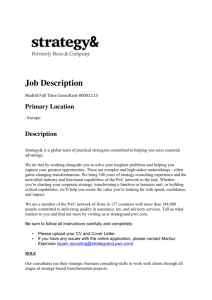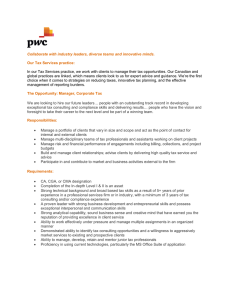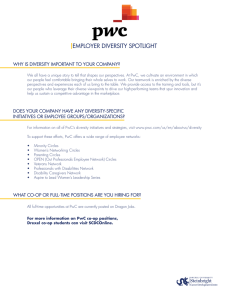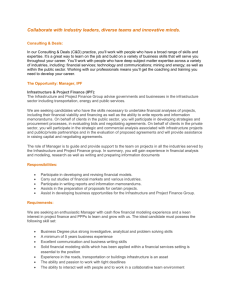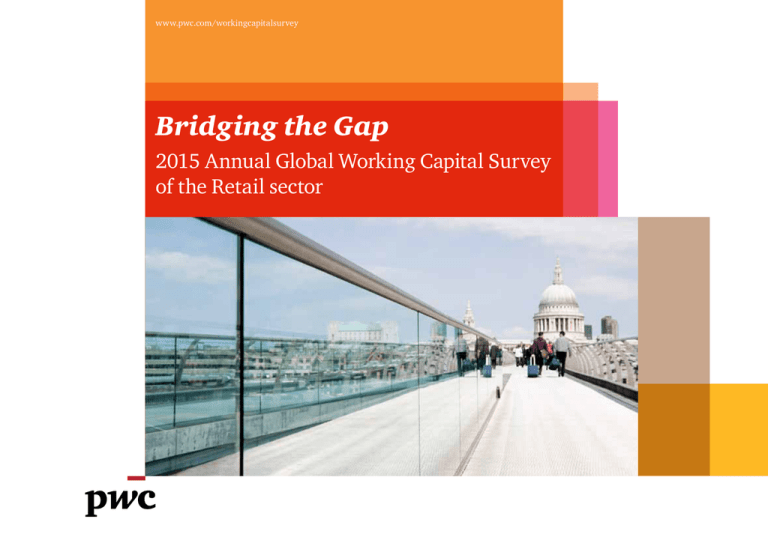
www.pwc.com/workingcapitalsurvey
Bridging the Gap
2015 Annual Global Working Capital Survey
of the Retail sector
Contents
Foreword
3
2
Executive
summary
4
PwC – Bridging the Gap
Sector
7
Sub-sector
13
How we can
support you
21
Appendices
24
Contacts
28
Foreword
Foreword
Executive
summary
Welcome to PwC’s working capital survey of the
retail sector.
We work with many retail clients as to
improve their working capital, helping
them optimise and achieve sustainable
cash flows.
Appendices
I hope you find this survey of interest.
Contacts
Overall the sector has improved its working
capital; many have improved demand
forecasting and the agility of their supply
chain as e-commerce demands more
accurate availability. However, there is
a spread in working capital performance
between the top and bottom performers
within the sector. With around €84bn of
working capital identified in the sector, there
is still a significant opportunity available.
Working Capital initiatives release cash
and increase liquidity that can be used
for strategic investments in customer
experience or the reduction of debt.
How can we
support you?
Many retailers have embarked on working
capital optimisation programmes,
particularly as they wrestle with how to
provide appropriate availability without
increasing inventory substantially.
Sub-sector
Madeleine Thomson
UK Leader of Retail &
Consumer, PwC
Sector
Working capital tells us a lot about how well a company
is managed. It is an indicator of good management,
as top working capital performers tend to out perform
their peers across other indicators.
2015 Annual Global Working Capital Survey in the Retail sector
3
Executive summary
€84bn cash opportunity available
to bridge the gap for future growth
Retail companies have been benefiting from significant
growth last year. However, this growth needs cash to
sustain it. As a result retail companies have focused on
working capital and have improved their performance.
In this study we look at the performance
trends of working capital within the
industry sector and its related sub-sector.
Our findings show that working capital
performance has improved in 2014,
breaking the negative trend of the last
four years. Retailers have woken up to
the benefits of closely managing working
capital. Improvements are visible in all
retail sub-sectors and nearly across all
regions, with the exception of Australasia.
4
PwC – Bridging the Gap
The spread of performance between top and
bottom companies in every working capital
component shows that improvements are
possible across all sub-sectors.
Having already helped to release more than
€26bn cash benefits around the world, we
believe we are in the best position to help
your company optimise working capital.
Daniel Windaus
Working Capital Partner
Sector
jump in revenue in 2014
with the exception
of Australasia have
improved working
capital in 2014
Executive
Summary
14%
Improved working
capital
performance,
breaking the negative
trend of the last
four years
Foreword
All regions
Sub-sector
How can we
support you?
Significant
spread
Speciality retail
has the highest
NWC ratio
Appendices
of NWC
performance
across
the sector
Contacts
of sub-sectors
have improved in 2014
2015 Annual Global Working Capital Survey in the Retail sector
5
6
PwC – Bridging the Gap
Retail
Foreword
14%
Sub-sector
r performan
cto
ce
e
S
Sector
breaking the negative trend
of the last four years
r perfor
m
ecto
an
b -s
ce
Su
Improved working
capital performance,
Executive
Summary
jump in
revenue
in 2014
How can we
support you?
Appendices
Inventory
Contacts
is the largest area
for improvement
2015 Annual Global Working Capital Survey in the Retail sector
7
Our study looks at 872 companies in the retail sector with revenues above €100 million
Number of retail companies in the study by region
17 Africa
24 Australasia
18 Middle East
40 Americas
147 Europe
192 USA, Canada
434 Asia
Revenue of retail companies in the study by region (€ billion)
13 Middle East
97 Australasia
55 Africa
144 Americas
664 Asia
849 Europe
1,668 USA, Canada
8
PwC – Bridging the Gap
Foreword
The sector experienced a healthy jump in revenues by 14% in the past year, increasing the need for cash
Executive
Summary
Retail revenue trends
14%
Sector
6.1%
2.3%
9.8%
Sub-sector
€2.57bn
How can we
support you?
Rev 2010 Rev 2011 Rev 2012 Rev 2013 Rev 2014
Revenue
Appendices
% Percentage increase / decrease
Contacts
2015 Annual Global Working Capital Survey in the Retail sector
9
The need for cash has translated in an improvement of the working capital ratio by 3%
Retail sector NWC as a % of revenue (€ million)
NWC %
2014: 3,490,734
5.6
2013: 3,062,508
5.9
5.9
6.2
6.0
2012: 2,994,059
DIO
2011: 2,822,913
DPO
2010: 2,571,430
Revenue
17.3
16.9
17.1
62.1
62.1
17.0
16.9
63.0
62.8
NWC %
5.6%
5.9%
5.9%
6.0%
6.2%
Working capital performance has improved in 2014, breaking the negative
trend of the last four years. This improvement was driven primarily by
improvements in accounts payable, and continuously short receivables days.
10
PwC – Bridging the Gap
DSO
58.9
54.6
55.3
2010
2011
55.9
2012
55.0
2013
55.8
2014
5.2
2010
Australasia
2011
2012
2013
2.1
2014
2010
2.8
2.6
Australasia
2.7
2.6
2012
2013
2014
Europe
2.8
2.6
2.1
2011
2.7
2.6
4.3
3.9
3.7
3.5
3.5
2011
2012
4.3
3.7
2011
2012
2011
5.7
2012
2013
2014
6.0
2013
2014
6.5
2012
6.0
2014
2011
6.8
USA, Canada
5.7
5.6
2012
5.2
2013
2011
2012
2011
Africa5.6
2013
Americas
2014
5.6
2011
6.5
2010
2011
2012
Americas
2010
2011
2013
2013
2014
6.6
2012
9.7
2013
9.2
2014
2014
Asia
10.6
6.3
2010
6.6
2011
6.6
2013
6.6
12.5 2011
6.8
2014
6.6
6.5
12.4 2012
2013
Asia
2010
2011
2014
6.9
9.3
2012
7.3
9.7
2013
6.9
9.2
2014
6.9
Australasia
5.2
2013
NWC %
2014
2012
2013
7.3
2014
6.9
6.3
2.8
2010
2011
2.6
2012
2.6
2013
2012
2013
2.7
2014
2011
2.8
2.6
10.6
9.3
2012
2013
2014
4.3
2.1
Africa
12.5
12.4
2010
2011
6.9
2010
Americas
2012
2013
2014
2011
2012
2013
2014
2011
Middle East
2013
2014
3.5
2012
2013
2014
4.3
3.7
3.9
3.5
2015 Annual Global Working Capital
Survey in the Retail sector
3.5
6.7
2010
11.2
3.9
Europe
6.9
5.2
2011
2010
2.7
6.3
3.7
2012
7.0
5.6
7.3
2.7
Europe
9.2
3.5
Asia
2014
Contacts
2011
9.7
2.6
Appendices
2.1
Australasia
2010
11.2
2010
2012
11.2
Americas
2010
12.4
7.0
9.3
6.8
6.6
2014
2.7
2012
2014
12.5
2.7
10.6
2010
6.6
2012
5.2
11.2
7.0
2011
2010
5.2
2010
5.6
2013
7.0
How can we
support you?
Africa
2010
2010
5.2
12.4
Sub-sector
2011
2013
5.7
3.5
2012
12.5
2.7
3.9
3.7
2014
5.6
USA, Canada
5.6
2013
Africa
6.7
3.5
2011
2010
USA, Canada
6.6
6.7
2012
Middle East
4.3
3.5
2011
2014
Sector
6.0
2010
2013
Middle East
6.7
6.6
2012
Europe 3.9
2010
Middle East
2010
2011
Executive
Summary
3.5
2014
2010
2010
Europe
2010
2.1
2013
Foreword
All regions with the exception if Australasia have improved working capital
2010
2011
6.0
2012
5.7
2013
5.6
2014
11
12
PwC – Bridging the Gap
Retail Sub-sector
Foreword
Apparel, accessories &
luxury goods Executive
Summary
working capital
improved by
Sector
Sub-sector
How can we
support you?
five year best of 8%
in 2014
r performan
cto
ce
Se
General merchandising
achieved a working capital
ctor performa
-se
nc
b
e
Su
3%
Appendices
Online and
catalog retail
Contacts
receivables and
inventory days
marginally
improved
in 2014
2015 Annual Global Working Capital Survey in the Retail sector
13
Apparel, Accessories & Luxury Goods
DSO
DIO
60
50
200
51
54
50
51
181
52
168
177
184
190
Apparel, accessories and luxury goods revenue and NWC % (€ million)
40
2014: 506,691
150
Revenue
2013: 444,855
2012: 425,615
NWC %
30
28
29
28
27
27
20
2011: 385,574
2010: 345,781
10
123
11
11
12
11
9
72
DPO
86
xx
82
84
83
59
60
59
32
33
80
65
63
36
35
60
40
31
20
2010 2011 2012 2013 2014
14
PwC – Bridging the Gap
77
Top performers
87
Performance within the apparel, accessories & luxury goods sub-sector has
improved by 3%. This improvement has been due to small improvements on
the asset side. However, DPO overall showed a negative trend over the five year
period.
79
Key
100
18.1%
75
130
2010 2011 2012 2013 2014
17.6%
17.4%
78
134
50
2010 2011 2012 2013 2014
17.9%
127
100
0
16.1%
132
Weighted average performance
Bottom performers
DSO
Food and Drinks
DIO
15
50
13
Food and drinks revenue and NWC % (€ million)
Revenue
2013: 1,610,984
2012: 1,580,896
NWC %
12
11
11
12
11
11
47
48
38
38
37
19
20
20
50
11
40
11
37
9
38
30
Executive
Summary
2014: 1,794,983
12
49
Foreword
12
47
6
2011: 1,487,695
20
3
2010: 1,363,834
1
1
18
1
1
10
2010 2011 2012 2013 2014
80
Key
77
76
75
Top performers
73
74
-0.7%
xx
Weighted average performance
How can we
support you?
70
-0.2%
2010 2011 2012 2013 2014
Sub-sector
DPO
18
Sector
0
2
Bottom performers
0.1%
0%
0.2%
60
53
51
50
32
33
33
33
52
Appendices
54
50
Food and drink companies show close to negative levels of working capital and
benefit from short DSO on the customer side due to the ‘cash and carry’ nature of
the sector. Inventories remain the largest area of opportunity.
40
Contacts
30
35
2010 2011 2012 2013 2014
2015 Annual Global Working Capital Survey in the Retail sector
15
General Merchandising
DSO
40
DIO
38
38
34
109
NWC %
80
20
20
18
18
71
17
10
0
40
2
2
2
2
2
111
77
79
80
78
46
48
DPO
Key
Top performers
xx
9%
80
84
81
79
80
81
53
58
60
59
59
38
38
38
38
38
8%
8.5%
60
Overall working capital performance for the sub-sector achieved a five year best
in 2014. This was achieved by a combination of halting the four year increase in
inventory, while slightly increasing payables days. With the normal product range
complexity of the sector, inventory remains the largest area of opportunity.
40
20
2010 2011 2012 2013 2014
45
2010 2011 2012 2013 2014
100
8.4%
39
43
20
2010 2011 2012 2013 2014
PwC – Bridging the Gap
113
17
2010: 591,133
16
111
60
2011: 633,509
8.4%
110
100
Revenue
2013: 650,737
2012: 645,301
120
35
30
General merchandising revenue and NWC % (€ million)
2014: 756,871
38
Weighted average performance
Bottom performers
Online and Catalog Retail
DSO
50
2014: 171,680
Revenue
80
38
38
36
34
40
41
42
35
37
35
68
71
66
66
70
Foreword
40
Online and catalog retail revenue and NWC % (€ million)
DIO
60
30
45
48
47
46
45
10
11
40
2013: 126,847
2012: 108,276
Executive
Summary
NWC %
20
2011: 89,272
20
2010: 64,001
2.4%
10
7
7
8
10
6
0
10
13
Sector
6
0
2010 2011 2012 2013 2014
2010 2011 2012 2013 2014
2.5%
1.4%
1.8%
Key
150
Top performers
135
1.8%
Sub-sector
DPO
112
117
115
Weighted average performance
How can we
support you?
120
xx
Bottom performers
103
90
91
93
38
37
39
87
85
Appendices
Online and catalog retail remains close to its five year high in terms of working
capital ratio. Both receivables and inventory days showed marginal improvement
in 2014, most of which is cancelled out by the deterioration in payables.
93
60
38
Contacts
30
35
2010 2011 2012 2013 2014
2015 Annual Global Working Capital Survey in the Retail sector
17
Specialty Retail
DSO
DIO
35
250
30
Specialty retail revenue and NWC % (€ million)
25
29
25
28
Revenue
2013: 229,086
2012: 233,970
NWC %
31
24
22
2014: 260,509
30
20
30
200
2010: 206,681
5
5
4
5
83
134
96
96
70
DPO
2010 2011 2012 2013 2014
Key
80
Top performers
72
70
67
68
68
71
60
57
20.5%
58
55
50
40
39
30
20
40
29
23
29
24
xx
Weighted average performance
Bottom performers
20.8%
26
2010 2011 2012 2013 2014
PwC – Bridging the Gap
85
137
50
2010 2011 2012 2013 2014
18
129
5
0
Specialty retail has by far the highest working capital ratio of all sub-sectors
within retail. This is due to one of the shortest payables days combined with the
highest inventory days. Managing assortment has to be one of the key focus areas
for this sector.
125
206
21
100
3
20.3%
122
206
23
15
10
19.4%
194
150
2011: 226,863
21%
201
195
Foreword
Executive
Summary
Sector
Sub-sector
How can we
support you?
Appendices
Contacts
19
2015 Annual Global Working Capital Survey in the Retail sector
The improvement programme looks at the supply chain operation, finance processes and the impact of the supplier
commercial terms on working capital
Suppliers
commercial
terms
improvement
Finance process
improvement &
compliance
Supply chain
structural, process
improvement &
compliance
20
PwC – Bridging the Gap
Payments terms and conditions
Operational service levels & range
Trade investments/Rebates collections
• Payment terms (days)
• Payment processing (excluding daily)
• Back and front margin split
•
•
•
•
•
•
•
•
•
Payables processing
Inventory costing
Receivables processing
•
•
•
•
•
•
•
•
•
•
• Receivables process & compliance
• Dispute management & overdue debt
management process
• Billing frequency/Timeliness/Collections
• Invoice discounting
Payables process & compliance
Early/Late payment eradication
Payment frequency
Accounting period improvement
Vendor financing /Reverse factoring
Agreement on range/assortment
LTL, FTL, MOQ, case size
Replenishment frequency
Lead time, OTIF, quality
Consignment/VMI, drop ship, incoterms
Inventory accounting method
Activity based costing/Cost to serve
Inventory capitalisation adjustment
Inventory write downs/write-offs
Inventory control
Trade investment/Rebates activities
Rebates requirements/Trade activities
Rebate/Back margin collection
Clearance funding
Network development & design
Distribution centres
Stores
•
•
•
•
•
•
•
• Distribution centres operations,
capability, accuracy, speed & efficiency
• Distribution centres replenishment
parameters and inventory policies
• Open to buy control
• Consignment stock
•
•
•
•
•
•
•
Supplier performance
In-sourcing/Outsourcing
International vs near sourcing
Suppliers: on-board/discontinue
Network design/Multi-channel
Opening/Closing of stores
Supply chain consolidation
Procure to pay
Pay on scan/Payment processing
Promotions planning & execution
SKU rationalisation
Planograms and visual merch.
Stores operations & replenishment
Demand planning and forecasting
Product lifecycle management
Forecast to fulfil
Order to cash
Foreword
How can we support you
Examples of areas where PwC could help you to
release cash from working capital:
Complete a
working capital
benchmarking
exercise to
compare
performance
against peers
and identify
potential
improvement
opportunities.
Perform a
diagnostic
review to
identify ‘quick
wins’ and
longer‑term
working capital
improvement
opportunities.
Develop
detailed action
plans for
implementation
to generate
cash and make
sustainable
improvements.
Assist the
realisation of
sustainable
working capital
reduction by
implementing
robust,
efficient and
collaborative
processes.
• Credit risk policies
• Aligned and optimised
customer terms
• Billing timeliness
and quality
• Contract and
milestone management
• Prioritised and proactive
collection procedures
• Systems‑based
dispute resolution
• Dispute root
cause elimination
• Asset based lending /
securitisation
Accounts payable
• Consolidated spending
• Increased control with
centre-led procurement
• Purchasing channels to
avoid leakage
• Aligned and optimised
payment terms
• Supply chain finance
• Payment methods
and frequency
• Eradicated early
payments
How can we
support you?
4
Sub-sector
3
Sector
2
Executive
Summary
1
Accounts receivable
Appendices
Inventory
• Process compliance and monitoring.
• Creating and embedding a ‘cash
culture’ within the organisation,
optimising the trade‑offs between
cash, cost and service.
• Lean and agile supply
chain strategies
• Global coordination
• Forecasting techniques
• Production planning
• Accurate tracking of
inventory quantities
• Differentiated inventory
levels for different goods
• Balanced cash, cost
and service
• Asset based lending
2015 Annual Global Working Capital Survey in the Retail sector
Contacts
Addressing the key levers:
• Identification, harmonisation and
improvement of commercial terms.
• Process optimisation throughout the
end‑to‑end working capital cycles.
21
22
PwC – Bridging the Gap
26bn
€
Receivables reductions
20% – 40%
Payables improvements
20% – 80%
Inventory reductions
15% – 50%
Net working capital improvements
30% – 70%
Quick wins as % of total opportunity
5% – 15%
Working capital as % of sales
5% – 10%
Sub-sector
We deliver substantial benefits,
typically between
Range of improvement
Sector
of Working Capital
benefits
Typical project results
Executive
Summary
We have helped to deliver over
Foreword
Our team has helped deliver significant working capital
benefits around the world
Challenges in working capital optimisation:
of revenue
Perception:
Complexity:
1
3
2
4
Sustainable improvements are
complex, requiring an operational
and cross functional approach
Driven by people:
Needs hands‑on approach
‘on the shop floor’ to change
operational behaviour
Contacts
We deliver
results fast,
Improvements require
structural changes for many
interrelated processes
Cross functional:
Appendices
Working capital is an operational
issue, but is often perceived to sit
with finance
How can we
support you?
5-10%
typically 5 -15% of
improvements
are quick wins
2015 Annual Global Working Capital Survey in the Retail sector
23
Appendices
24
PwC – Bridging the Gap
Foreword
Basis of calculations and limitations
Limitations of this study
Companies have been assigned to
countries based on the location of their
headquarters. Although a significant
part of sales and purchases might be
realised in that country, it does not
necessarily reflect typical payment
terms or behaviour in that country.
(Accounts receivable + inventories
– accounts payable)/Sales
DSO (Days sales outstanding)
DSO is a measure of the average number of
days that a company takes to collect cash
after the sale of goods or services have
been delivered.
Accounts receivable/Sales x 365
DIO (Days inventories on-hand)
DIO gives an idea of how long it takes for a
company to convert its inventory into sales.
Generally, the lower (shorter) the DIO,
the better.
Inventory/COGS x 365
DPO (Days payables outstanding)
DPO is an indicator of how long a company
takes to pay its trade creditors.
Accounts payable/COGS x 365
CCE (Cash conversion efficiency)
CCE is an indicator of how efficiently a
company is able to convert profits into cash.
Cash flow from operations/EBITDA
As the research is based on publicly
available information, all figures are
financial year-end figures.
Due to disproportionate management
efforts to improve working capital
performance towards year-end (also
referred to as ‘window dressing’)
the real underlying working capital
requirement within reporting periods
might be higher. Also off-balance-sheet
financing or the effects of asset
securitisation (e.g. receivables)
have not been taken into account.
Contacts
2015 Annual Global Working Capital Survey in the Retail sector
Appendices
NWC % measures working capital
requirements relative to the size of
the company.
How can we
support you?
NWC % (Net working capital %)
Sub-sector
Basis of calculation
Sector
Metric
Executive
Summary
Basis of calculations
This study provides a view of global working capital performance in the retail sector and is based
on the research of 872 companies in the world. For consistency reasons and to be able to add the
individual ratios together we have calculated DSO based on sales, DPO and DIO based on Cost of
Goods Sold (COGS).
25
Summary data
Primary industry
Number of companies
Africa
Americas
Asia
Australasia
Europe
Middle East
USA, Canada
Apparel, accessories and luxury goods
2
9
142
7
48
4
65
277
Food and drinks
6
11
85
2
29
9
22
164
General merchandising
6
16
152
11
34
4
54
277
1
27
1
16
22
67
Online and catalog retail
NWC % 2014
Specialty retail
3
3
28
3
20
1
29
87
Grand total
17
40
434
24
147
18
192
872
Primary industry
Africa
Americas
Asia
Australasia
Europe
Middle East
USA, Canada
Total
Apparel, accessories and luxury goods
33.6%
41.2%
16.8%
13.5%
21.1%
21.8%
12.8%
17.6%
Food and drinks
-0.7%
-2.4%
1.2%
1.0%
-3.9%
-0.9%
2.6%
0.1%
General merchandising
8.3%
20.5%
1.4%
13.0%
7.1%
22.7%
1.5%
10.8%
-2.1%
0.1%
Online and catalog retail
DSO 2014
9.4%
8.0%
-0.1%
2.4%
Specialty retail
37.6%
51.2%
31.2%
23.7%
14.1%
6.6%
17.9%
20.3%
Grand total
12.4%
9.2%
6.9%
2.7%
3.5%
5.2%
6.6%
6.0%
Primary industry
Africa
Americas
Asia
Australasia
Europe
Middle East
USA, Canada
Total
Apparel, accessories and luxury goods
20
115
34
20
28
39
19
27
Food and drinks
16
7
21
4
12
25
7
11
General merchandising
29
78
13
33
24
38
11
17
41
70
3
22
25
35
7
81
35
6
41
13
18
30
20
37
25
7
19
27
11
17
Online and catalog retail
Specialty retail
Grand total
26
Total
PwC – Bridging the Gap
Foreword
Primary industry
Apparel, accessories and luxury goods
Africa
Americas
Asia
Australasia
Europe
Middle East
USA, Canada
262
123
90
122
226
118
90
130
Food and drinks
47
57
36
42
36
35
38
38
General merchandising
78
85
62
86
84
118
83
78
83
38
29
58
45
45
Online and catalog retail
258
232
191
258
112
62
121
135
Grand total
107
75
61
49
66
55
60
63
Africa
Americas
Asia
Australasia
Europe
Middle East
USA, Canada
66
54
49
55
98
48
42
59
70
78
59
43
68
70
35
52
General merchandising
77
61
48
59
86
85
90
73
64
81
130
77
44
90
54
39
44
35
93
49
39
55
Grand total
70
80
62
45
74
65
42
56
Africa
Americas
Asia
Australasia
Europe
Middle East
USA, Canada
Total
769
676
5,328
71
11,300
34
3,504
21,682
Food and drinks
134
198
2,246
0
385
61
6,977
10,001
General merchandising
287
3,921
5,269
826
1,441
285
19,269
31,299
108
4,632
1
403
710
5,853
165
2,100
4,702
52
1,596
0
6,087
14,703
1,355
7,003
22,176
951
15,125
379
36,548
83,538
Specialty retail
Grand total
Appendices
Apparel, accessories and luxury goods
Online and catalog retail
How can we
support you?
Specialty retail
Sub-sector
Apparel, accessories and luxury goods
Primary industry
Total cash opportunity
from working capital
(€ million)
Total
Food and drinks
Online and catalog retail
Sector
Specialty retail
Primary industry
DPO 2014
Total
Executive
Summary
DIO 2014
Contacts
Highest opportunity
Low opportunity
2015 Annual Global Working Capital Survey in the Retail sector
27
Contacts
Daniel Windaus
Glen Babcock
Robert Smid
Daniel Windaus
Partner
T: +44 20 7804 5012
E: daniel.windaus@uk.pwc.com
Glen Babcock
Partner
T: +44 20 7804 5856
E: glen.babcock@uk.pwc.com
Robert Smid
Partner, Working Capital Practice Leader
T: +44 20 7804 3598
E: robert.smid@uk.pwc.com
Daniel is a partner in our working capital practice, with
over sixteen years of working capital experience.
He has advised company management and private equity
investors on improving cash flow throughout Europe and
North America.
Glen is a partner in our working capital practice,
leading our work across the regions of the UK.
He has worked with companies across the UK,
Europe and internationally about cash flow
improvement and cost reduction.
Robert leads our working capital practice and brings
over twenty years of working capital advisory
experience. He has made an instrumental difference
to the free cash flow and balance sheet structure of
many companies.
Alain Fares
Simon Boehme
Stephen Tebbett
Alain Fares
Senior Manager
T: +44 78 7825 0848
E: alain.fares@uk.pwc.com
Simon Boehme
Director
T: +44 20 7212 6927
E: simon.t.boehme@uk.pwc.com
Stephen Tebbett
Director
T: +44 20 7213 5511
E: stephen.tebbett@uk.pwc.com
Alain is a working capital senior manager with over
12 years experience in working capital and supply chain
optimisation. Alain is an expert in working capital and
supply chain optimisation in the retail
and consumer sector.
Simon is a director in our working capital practice.
He has over 10 years of experience advising
companies on working capital management across
Europe, North America, Asia and the Middle East.
Stephen is a Director in our working capital practice
and brings over 13 years of experience delivering
sustainable improvements in both corporate and
PE-backed organisations across the world. He has
worked across a diverse range of industries including
deep experience in retail.
28
PwC – Bridging the Gap
Working capital management global network
Petr Smutny
T: +42 25 115 1215
E: petr.smutny@cz.pwc.com
Bent Jorgensen
T: +45 3945 9259
E: bent.jorgensen@dk.pwc.com
Finland
France
Germany & Austria
Hong Kong
Michael Hardy
T: +358 50 346 8530
E: michael.hardy@fi.pwc.com
Francois Guilbaud
T: +33 156 578 537
E: francois.guilbaud@fr.pwc.com
Rob Kortman
T: +49 1709 879253
E: rob.kortman@de.pwc.com
Ted Osborn
T: +852 2289 2299
E: t.osborn@hk.pwc.com
Italy
Malaysia
Middle East
Norway
Riccardo Bua Odetti
T: +39 026 672 0536
E: riccardo.bua.odetti@it.pwc.com
Ganesh Gunaratnam
T: +603 2173 0888
E: ganesh.gunaratnam@my.pwc.com
Mihir Bhatt
T: +971 4304 3641
E: mihir.bhatt@ae.pwc.com
Jørn Juliussen
T: +47 95 26 00 60
E: jorn.juliussen@no.pwc.com
Singapore
Spain
Sweden
Switzerland
Peter Greaves
T: +65 6236 3388
E: peter.greaves@sg.pwc.com
Josu Echeverria
T: +34 91 598 4866
E: josu.echeverria.larranga@es.pwc.com
Jesper Lindbom
T: +46 70 9291154
E: jesper.lindbom@se.pwc.com
Reto Brunner
T: +41 58 792 1419
E: reto.brunner@ch.pwc.com
The Netherlands & Belgium
Turkey
USA
Danny Siemes
T: +31 88 792 42 64
E: danny.siemes@nl.pwc.com
Gokdeniz Gur
T: +90 212 376 5332
E: gokdeniz.gur@tr.pwc.com
Paul Gaynor
T: +1 925 699 5698
E: paul.m.gaynor@us.pwc.com
Appendices
Christine Catasta
T: +43 1 501 88 1100
E: christine.catasta@at.pwc.com
How can we
support you?
Jonas Schofer
T: +612 8266 4782
E: jonas.schofer@au.pwc.com
Sub-sector
Denmark
Sector
CEE
Executive
Summary
Austria
Foreword
Australia
Contacts
2015 Annual Global Working Capital Survey in the Retail sector
29
Notes
30
PwC – Bridging the Gap
Notes
2015 Annual Global Working Capital Survey in the Retail sector
31
www.pwc.com/workingcapitalsurvey
At PwC, our purpose is to build trust in society and solve important problems. We’re a network of firms in 157 countries with more than 208,000 people who
are committed to delivering quality in assurance, advisory and tax services. Find out more and tell us what matters to you by visiting us at www.pwc.com.
This publication has been prepared for general guidance on matters of interest only, and does not constitute professional advice. You should not act upon
the information contained in this publication without obtaining specific professional advice. No representation or warranty (express or implied) is given as
to the accuracy or completeness of the information contained in this publication, and, to the extent permitted by law, PwC does not accept or assume any
liability, responsibility or duty of care for any consequences of you or anyone else acting, or refraining to act, in reliance on the information contained in this
publication or for any decision based on it.
© 2016 PwC. All rights reserved. PwC refers to the PwC network and/or one or more of its member firms, each of which is a separate legal entity.
Please see www.pwc.com/structure for further details.
Design Services 29192 (10/15).

